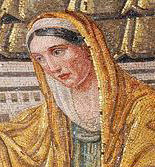
Pudentiana is a virgin and martyr of the 2nd century who refused to worship the Roman Emperors Marcus Aurelius and Antoninus Pius as deities. She is sometimes locally known as "Potentiana" and is often coupled with her sister, Praxedes the martyr.

Musti or Mustis was an ancient city and bishopric in the Roman province of Proconsular Africa, now in northern Tunisia. Its ruins, called Mest Henshir, are about eight miles from Dougga, near Sidi-Abd-Er-Rebbou. It is also a Catholic titular see.
Usilla or Usula was a town in the Roman province of Byzacena, now Inchilla in Tunisia.
Bageis, Bagis (Βάγις), or Bage (Βάγη) was an ancient Greek city in the province of Lydia in Asia Minor.
Dometiopolis was a city of Cilicia Trachea, and in the later Roman province of Isauria in Asia Minor. Its ruins are found in the village of Katranlı, Ermenek, Karaman Province, Turkey.

Lyrbe was an ancient city and later episcopal see in the Roman province of Pamphylia Prima and is now a titular see.
Orcistus or Orkistos was a city originally in the northeast of ancient Phrygia and later a bishopric in the Roman province of Galatia Secunda, situated south of the town now called Ortaköy, Afyonkarahissar, and previously Alikel Yaila.
Sasima was a town of ancient Cappadocia and in the late Roman province of Cappadocia Secunda, located 24 Roman miles to the south of Nazianzus.
Leuce was a town and episcopal see in the late Roman province of Thracia.
Tabae or Tabai was a city in ancient Caria, although, according to Strabo it was located in a plain in Phrygia on the boundaries of Caria. The place is now Tavas, near Kale, Denizli in Turkey; some inscriptions and numerous ancient remains have been found.
Casius or Casium was a residential episcopal see in the Roman province of Augustamnica Prima in Lower Egypt, and is now a titular see of the Catholic Church.
Cestrus was a city in the Roman province of Isauria, in Asia Minor. Its placing within Isauria is given by Hierocles, Georgius Cyprius, and Parthey's. While recognizing what the ancient sources said, Le Quien supposed that the town, whose site has not been identified, took its name from the River Cestros and was thus in Pamphylia. Following Lequien's hypothesis, the 19th-century annual publication Gerarchia cattolica identified the town with "Ak-Sou", which Sophrone Pétridès called an odd mistake, since this is the name of the River Cestros, not of a city.
Dausara is a former residential episcopal see in the Roman province of Osrhoene, a suffragan of Edessa. It is now a titular see of the Catholic Church.
Marciana was a town in ancient Lycia, with a bishopric that was a suffragan of that of Myra.
Tadamata was a town in the Roman province of Mauretania Caesariensis.
Polystylus is the name of an ancient town and bishopric in the late Roman province of Macedonia Secunda, whose metropolis was Philippi. Its name is given in this form in the Catholic Church's list of titular sees. A 1911 article by Sophrone Pétridès called it Polystylum.
Trapezopolis or Trapezoupolis (Τραπεζούπολις) was a city of ancient Caria, and later in the late Roman province of Phrygia Pacatiana Prima.
Lysias was a city and episcopal see in the Roman province of Phrygia Salutaris I and is now a titular see.
Musti in Numidia, also called Musti Numidiae, was an ancient city and bishop jurisdiction (bishopric), and is presently a Catholic titular see,(bishop's government see of a former government under a church's responsibility, also known as a dead diocese.) in modern Algeria.
Alia was a town of ancient Phrygia, inhabited in Roman and Byzantine times. It was located in the Roman province of Phrygia Pacatiana, whose capital was Laodicea on the Lycus, and became the seat of a bishop. The names of some of the bishops of Alia are known through their participation in church councils: Caius at the Council of Chalcedon (451), Glaucus at the Second Council of Constantinople (553), Leo at the Second Council of Nicaea (787), and Michael and Georgius, the one a supporter of Patriarch Ignatius of Constantinople, the other a supporter of Photius, at the Council of Constantinople (879).




